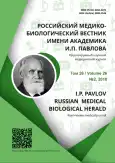Mud therapy in the rehabilitation of patients with cervical dorsopathy
- Authors: Filatova E.V.1, Malayev K.M.2, Konovalov O.E.3
-
Affiliations:
- Central State Medical Academy of Department of Presidential Affairs of the Russian Federation
- Republician Hospital of Rehabilitation
- Russian Peoples Friendship University
- Issue: Vol 26, No 2 (2018)
- Pages: 280-287
- Section: Original study
- URL: https://journals.rcsi.science/pavlovj/article/view/9106
- DOI: https://doi.org/10.23888/PAVLOVJ2018262280-287
- ID: 9106
Cite item
Abstract
Aim. To identify specificity of reaction of a male and female organism to galvanic mud application procedures in cervicalgia.
Materials and Methods. 48 Patients (23 men and 25 women) with the diagnosis of cervicalgia who took a course of rehabilitation treatment in Republican Hospital of Rehabilitation Treatment of Makhachkala, were examined. The patients received medicinal treatment and medical massage. Galvanic mud therapy was conducted with the underlying standard therapy. The effectiveness and safety of the procedure were evaluated using visual analog scale (VAS), and also parameters of the arterial pressure and heart rate before and after the procedure, and also values of Kerdo vegetative index, body mass index, mobility of the cervical part of the spine, psychoemotional condition by WAM test.
Results. Analysis of predomination and characteristics of pain syndrome revealed predomination of the damage to the upper cervical parts (in women – 62.0%, in men – 40.0%), and statistically more common cervicocranialgias in women (22.0% against 8.0% in men). Headaches associated with pain in the neck were reliably more common in women than in men (48.0% and 10.0%, respectively). A significant difference in the rate of complaints of pain irradiation to the upper limbs was recorded (20.0% of women against 10.0% of men). Intensity of pain syndrome determined by VAS test significantly differed in the compared groups before rehabilitation (5.25±1.64 points in men and 5.62±1.98 points in women, р<0.05); after rehabilitation treatment VAS parameters decreased in both groups: in men down to 1.62±0.83 points (р<0.05), in women – to 2.25±1.07 points (р<0.05), here, no significant differences between the groups were found. In women with cervicalgias the distance between the upper and lower cervical vertebrae was on average 14.0±0.1 cm, increment on bending before treatment was 2.43±0.75 cm and after treatment 2.75±0.11 cm which indicates a tendency to normalization of the condition of muscle tissue, but preservation of spastic component.
Conclusion. Mud therapy in complex rehabilitation of patients positively influences recovery of the motor activity of the cervical part of the spine.
Keywords
Full Text
##article.viewOnOriginalSite##About the authors
Elena V. Filatova
Central State Medical Academy of Department of Presidential Affairs of the Russian Federation
Email: konovalov_oe@mail.ru
ORCID iD: 0000-0003-3732-6680
SPIN-code: 5470-1139
MD, Grand PhD, Professor, Department of Medical Rehabilitation, Sports Medicine, Physical Therapy, Balneology and Physiotherapy
Russian Federation, Marshala Timoshenko str.,19, Moscow, 121359Khajimurat M. Malayev
Republician Hospital of Rehabilitation
Email: konovalov_oe@mail.ru
ORCID iD: 0000-0003-4331-618X
SPIN-code: 9905-0014
Chief Medical Officer, Republician Hospital of Rehabilitation Treatment
Russian Federation, Makhachskala, Republic of DagestanOleg E. Konovalov
Russian Peoples Friendship University
Author for correspondence.
Email: konovalov_oe@mail.ru
ORCID iD: 0000-0003-1974-9882
SPIN-code: 5181-8547
MD, Grand PhD, Professor of Department of Public Health, Health Care and Hygiene
Russian Federation, 6, Miklukho-Maklaya street, Moscow, 117198References
- Barinov AN, Parkhomenko EV. Tservikogennaya golovnaya bol' – differentsial'naya diagnostika i lechenie. Nevrologiya, neyropsikhiatriya, psikhosomatika. 2012;3:248. (In Russ).
- Akrakulova YuV, Vladimirskiy EV, Mullayanova EA. Potentsirovanie effekta bal'neogryazelecheniya pri nespetsificheskikh bolyakh v nizhney chasti spiny. Voprosy kurortologii i lechebnoy fizicheskoy kul'tury. 2014;6:349. (In Russ).
- Kasatkin DS. Nespetsificheskie boli v shee: taktika vedeniya patsienta. Consilium medicum. 2012;14(2):6570. (In Russ).
- Vosnesenskaya TG. Boli v spine i konechnostyakh. In: Golubeva LV, editor. Bolevye sindromy v nevrologicheskoy praktike. Moscow: MEDpressinform; 2010. P. 20249. (In Russ).
- Surskaya DS. Sovremennye aspekty lecheniya dorsopatii. Nevrologiya i psikhiatriya. 2009; 17(20):13114. (In Russ).
- Yahno NN. Bol': rukovodstvo dlya vrachey i studentov. Moscow: MEDpress; 2009. (In Russ).
- Gurlenya AM, Bagel' GE, Smychek VB. Fizioterapiya v nevrologii. Moscow: Medical literature; 2005. (In Russ).
- Bogolyubov VM. Fizioterapiya i kurortologiya. Moscow: Binom; 2012. (In Russ).
- Olefirenko VT. Vodoteplolechenie. 2e ed. Moscow: Medicina; 1978. (In Russ).
- Mel'nichuk PV, editor. Bolezni nervnoj sistemy. Moscow: Medicina; 1982. (In Russ).
- Golubev VL. Nevrologicheskie sindromy. Moscow: Jejdos Media; 2002. (In Russ)









